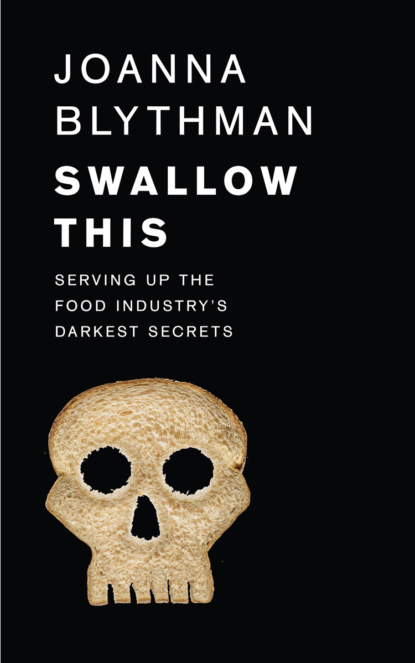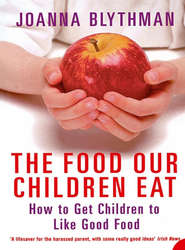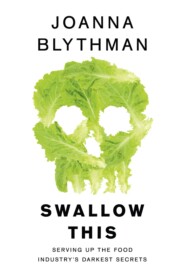По всем вопросам обращайтесь на: info@litportal.ru
(©) 2003-2024.
✖
Swallow This: Serving Up the Food Industry’s Darkest Secrets
Автор
Год написания книги
2019
Настройки чтения
Размер шрифта
Высота строк
Поля
Inside, their employees work long, demanding shifts: 12 hours isn’t unusual, sometimes night shifts. They tend to be young, and driven by a very strong work ethos, the kind of people who are prepared to take any job that’s going, seeing it as a stepping stone on the road to eventual financial betterment. Typically, some 90 per cent of the staff come from Eastern Europe and the Baltic States. In one workplace canteen I visited, the cook was Polish, making a daily bigos, Poland’s favourite cabbage and sausage stew.
Except for the odd tantalising glimpse of the external world from the canteen windows, these people work in artificial light, in a factory world. And outsiders most certainly cannot see in, a necessary measure to guard secret recipes and commercial confidentiality, we’re told.
So although these factories provide households up and down the land with billions of portions of processed food – half a million kebabs on just one day would not be unusual for a busy meat processing site – most of us haven’t a clue what these mammoth population-feeding units look like inside. They don’t run Doors Open Days, and any visitor, pre-arranged or otherwise, will be greeted by a uniformed guard, and a security barrier. Their unwritten motto? Transparency ain’t us. It’s not like the old days, when primary teachers would take classes to see a dairy farm and bottling plant so they could work up a cute little Day in the Life of a Pinta project. The prevailing sentiment amongst food manufacturers is that the less we have a mental picture of how our processed food is made, the better.
This defensiveness is understandable. Would most of us feel tempted by those attractively packaged and slickly marketed convenience foods, the sort of thing we choose in seconds then slip in the microwave of an evening, if we were allowed a sneak peek into the places where they were made? Not greatly, I’d wager. As for working there, they would definitely be one of the last places in the world that most people would ever want a job.
‘You see, we’re just a scaled-up version of a domestic kitchen’, one enthusiastic boss assured me as he showed me round his pride-and-joy ready meals factory. Another executive looked me in the eye and told me with apparent conviction, and perhaps a hint of nervousness, that his meat processing plant was ‘just like a biggish kitchen’. I nodded politely, but I didn’t get the analogy: it’s a food processor’s fairy tale with all the scary bits edited out.
Food manufacturers have created a body of lore and legend around their products that sounds tremendously comforting. ‘Recipes for these foods are gathered from all over the world and are created by chefs who are passionate about what they do’, says the Chilled Foods Association. ‘They [chefs] also like working with fresh ingredients and being involved right from the start – from initial concept to final food. They get their inspiration from different sources. Travel and cookery books are particularly important but they all love to experiment and research new ideas. Many chilled foods are hand-made in basically the same way as in the restaurant kitchen or in the home, so being able to create virtually any type of food is considered very satisfying.’
But whether they are geared up to manufacture crisps, frozen fish fingers, tinned fish, dried cereals, cheese slices, Rice Krispies®, or ready-to-microwave party canapés, factories don’t look, or feel, anything like a kitchen, even of the industrial catering sort. They more resemble car plants and oil refineries, or even the missile-launching pad at the end of Dr No, where James Bond sabotages the efforts of a small army of operatives, lost and almost robotic-looking within the bulk of their protective clothing.
Without a detailed, highly technical explanation, or a degree in engineering, chemical engineering, microelectronics, microbiology or food technology, most of us would find it extremely hard to see any parallels with domestic food production in these cavernous factories, because there are precious few sensual or visual cues. It’s not at all like those appetite-whetting TV adverts for pasta sauces, fish fingers, and other processed foods that show ‘our chefs’ in homely yet aspirational kitchens, surrounded by sensual displays of fresh, whole ingredients. It is most certainly not a dream job of browsing through recipe books and playing around with the world’s finest and freshest ingredients. In fact, it is actually relatively rare to see anything that looks much like food as we know it in these factories, and when you do, it will most likely be swathed in strong plastic, in giant tins and cartons, or packed in cardboard boxes and stored in a freezer.
Most cooks, even hardened professional chefs and caterers with experience of institutions such as prisons and hospitals, would find this environment unfamiliar and baulk at working there for a day, let alone for a lifetime. Many of the individual industrially proportioned units of equipment would fill a generous-sized sitting room. Grouped together, they could easily occupy the ground space of a football pitch and the height of a motorway petrol station forecourt.
These factories are laid out in one seamless, highly efficient assembly-line process, designed according to a flow diagram to create the sequence of steps and tasks in the manufacturing process. Depending on the company’s product lines, equipment can include spiral chillers, dehumidifiers, injectors, extruders, steam-jacketed kettles, centrifugal screeners, swept surface coolers, hoppers, sifters, oil conditioners, Stephan mixers, colloid mills, steam infusion and plate exchanger cookers, batch fryers, spray dryers, horizontal conveyor dryers, flash-cooling pumps, oven bands, freezer belts, horizontal agitators, batch and continuous lines, make-up lines, continuous mixers, high shear mixers, evaporators, and a whole apparatus of other kit that bears absolutely no resemblance to any home cook’s appliances and batterie de cuisine.
The equivalent here of a domestic saucepan is a steaming vat that would require a window cleaner’s ladder to look into, one with dimensions large enough to swallow up several Mafia informers at a time. Equipment clunks, spurts, grinds, squeezes, divides, stacks, minces, bakes, sucks, checks, injects, detects, chills, blasts, shapes, ploughs, agitates, steams, dries, forms, codes, freezes, defrosts, microwaves, churns, paddles, calibrates, signals, bleeps, hums, rolls, vibrates, and cools. Sauces are cooked by the ton then spewed out onto other food components that are cooked on a conveyor belt. One ready meals company is proud to say that its factory manufactures ten tons of chicken tikka a day.
The noise produced by these gargantuan pieces of plant is deafening. There’s no way that you’ll be humming along to Radio 2, or chatting with colleagues on the production line to help make the shift go by faster. There’s no possibility of any camaraderie here. Instead, if you’ve any sense, you’ll do what you can to protect your hearing and wear your company-provided ear plugs, then retreat for hours at a time into your own isolated, private world of thoughts, dreaming perhaps of being promoted to a better post, or finding another job doing something else entirely, until it’s time for a break.
And you will need to become accustomed to working in extreme temperatures. Apart from the warmer slaughterhouse and cooking stages, the ambient temperature in most zones of food factories is bitingly raw and cold, conditions that chill you down to the bone marrow. Anyone who works here will have to show endurance and stamina, and hopefully be in possession of a very robust immune system. If you tend to get a cold whenever you get chilled, you won’t last long. You will also need to get accustomed to the smells. The faintly bloody smell you might find in a traditional high street butcher is one thing, but that fleshy odour, scaled up and intensified on an amplified scale because of the high throughput of carcasses, is another. If you work in a factory specialising in crisps, fried breaded and battered foods, chips, or ‘hand-held’ snacks such as crisps and corn chips, you will come out smelling like the products you make; the fatty whiff hangs in your hair. The most off-putting smell that assailed me was in a ready meals factory, where the atmosphere was filled with the sweet, cloying scent of gloopy, viscous tomato sauce and starchy, sticky béchamel with a fragrance reminiscent of regurgitated baby milk. Maybe people who work there stop noticing it after a while. I hope so. Working in food processing facilities is hard graft in so many ways, so it is hardly surprising that a high staff turnover and high rates of sickness absence are par for the course, or that many major plants are consistently understaffed and rely on agencies to fill the gaps. The use of temporary agency labour is commonplace throughout the food industry, particularly to cover peaks in demand: the run-up to Christmas, for instance.
The less experienced jobs in food processing are so unremittingly monotonous, repetitive and unrewarding that they must surely depress the spirits and elevate stress levels. Who wants to spend 12 hours a day arranging meatballs as though they were boxes of chocolates, or checking that there are four cubes of meat in every portion of chicken casserole, according to the product specification? But some food processing jobs are highly skilled. Although most people would consider it the most grizzly, hellish job in the world, the slaughterhouse men who take a dead whole carcass and ‘dissemble’ it – that’s breaking it down into its main parts, stripping back the skin and hide, vacuuming out spinal cord, splicing heads in two, removing tendons and hoofs, brains, pancreas, kidneys, suet, collecting ears and thymus, emptying colons, examining lymph nodes, separating guts, cutting out the major bones, pulling off membranes, de-gristling and segregating everything that hasn’t a food or other use to produce fore- and hind-quarters for further butchery – are consummate experts.
Those whom I have seen working on the carcass ‘dissembly’ line move at a fierce pace: a state-of-the-art abattoir can break down a whole cow into quarters and bag them, in 40 minutes. There, staff typically operate non-stop for three and a half hours at a time in a hot, steamy, visceral atmosphere, demonstrating a certainty and adroitness that comes from experience. In food processing terms, they are well paid, because they have to concentrate intently, each and every second, on what they are doing.
Their task requires training, physical strength, endurance, precision knife skills, excellent hand-to-eye coordination, and a developed understanding of anatomy. Their brains need to be engaged every second. A slip of the knife, a moment’s lapse of attention, and a gory catalogue of accidents is waiting to happen. The jobs of these slaughtermen are repetitive, but they aren’t dull or unintelligent any more than that of the craft jeweller or clockmaker, who peers into the innards of watches all day, making minute adjustments and repairs.
For their part, the food-factory boss men, who have nice, bright, clean offices with lots of windows, upstairs, or in another building, talk not of ‘food’, but of ‘product’. The word ‘cooking’ doesn’t come into it; they use the more honest term: ‘manufacture’. Industry top brass refers not to ingredients, but ‘food ingredient technology’ and ‘food ingredients systems’. Their vocabulary speaks volumes about how companies view the job in hand.
Food processing executives have a long list of daily hygiene and food safety concerns, because danger is omnipresent in the industrial food system. Metal detection, for instance, requires an entire strategy, part of the ongoing military campaign to prevent any uninvited foreign object from getting into your microwaveable meal, sandwich or prepared salad. With so many complex, intricate pieces of industrial equipment in use, there is always a very real possibility that a screw, nut or some other piece of equipment drops into your macaroni cheese. Allergens are another constant bugbear. A trace of soya or peanut where it ought not to be, and a whole day’s production is scuppered.
Given the high risk inherent in industrial-scale food manufacture, record-keeping is critical. Every piece of equipment and ingredient must come with a paper trail to vouch for its origins and safety. The managers below the boss men have internal audits – essentially box-ticking exercises – coming out of their ears. They supervise elaborate coding schemes to ensure that each and every product that goes through the production process is traceable back to a specific batch, grade and type, made at a specific time of day. That’s no mean effort: a ready meals factory can be churning out 250,000 individual servings a day, made up of 60 or 70 different products, using ten different assembly lines. One leading ready meals manufacturer, for instance, boasts that it makes 2.5 million ready meals a week.
When large industrial plants are churning out such a product volume, you might think that public health authorities would drop in at intervals to check that everything is up to scratch. That happens, but not as frequently as you might assume. Official statistics show, for example, that more than 55 per cent of all registered UK food establishments did not receive a local authority health inspection or audit in the year April 2012 to March 2013. Julia Long, the Unite union’s national officer for the food sector, sums up this situation as follows:
Food processing is one of our fastest-growing industries, employing hundreds of thousands of workers. The industry needs an inspection regime that respects this and understands that public safety and confidence are paramount. At the moment, thanks to the running down of the service, a business can look forward to an inspection only once in a blue moon.
Instead, the food industry is largely left to monitor its own food hygiene and safety procedures, using a system known as HACCP: Hazard Analysis and Critical Control Point. This involves continuously monitoring every ‘critical control point’ where a likely hazard might arise – food poisoning bacteria, cross-contamination, and more – and keeping copious trails of paperwork to show that all possible checks have been vigilantly carried out. The emphasis in food chain regulation these days is on internal prevention, not external, independent inspection.
And yet, a lot can go wrong quickly when you manufacture convenience food at considerable speed on an industrial scale, and if it does, the consequences are extremely serious. If you’re talking food poisoning, the affected batch will have been loaded onto lorries, trucked to supermarket distribution centres, and laid out on shelves, making thousands of people ill within hours, in which case, there will be hell to pay. If the problem is rogue allergens, manufacturers will have to meet the considerable cost of a product recall. The penalties that can be imposed on them by retailers are severe, everything from being fined to losing the business.
The authorities will become involved, which is something of an embarrassment for the retailer, with knock-on consequences for the manufacturer. It could mean a ‘trade recall’, the recovery of the product from distribution centres, wholesalers, hospitals, restaurants, other major catering establishments, as well as other food processors, and/or it might also lead to a ‘consumer recall’, a complete withdrawal of the products from retail outlets. Product recall notices will have to be displayed in stores, along the lines of ‘If you have bought one of the products listed above, do not eat it. Instead, return it to the store it was bought from for a full refund or contact customer services’. Hundreds of thousands of refunds will have to be paid out.
Yet despite the dire consequences manufacturers face when their production goes wrong, recalls are surprisingly common in the UK. Barely a week goes by without one. Sometimes there are several recalls in one day. Take, for instance, 25 February 2014, when the Food Standards Agency (FSA) issued the following alert:
Sainsbury’s has recalled its ‘by Sainsbury’s’ Frozen Sticky Toffee Sponge Pudding, because the product may contain small pieces of metal.
This communication was swiftly followed by another:
Marks & Spencer has withdrawn its Lightly Dusted Salt and Pepper British Chicken Fillets because a small number of packs contain egg, which is not mentioned on the label. This makes the product a possible health risk for anyone who is allergic or has an intolerance to egg.
And yet another:
Sainsbury’s has withdrawn all packs of Sainsbury’s Taste the Difference Roasted Chestnut, Toasted Hazelnut & Thyme Stuffing because the product may contain traces of peanut due to cross contamination during manufacturing. This is not mentioned on the label making the product a possible health risk for anyone who is allergic to peanuts.
Presence of allergens is by far the most common reason for product recalls, but why is this? Obsessed with being cost-effective, many food processors operate the food factory equivalent of hot-desking by redeploying the same plant equipment and assembly line, often in the course of a day, to make several different products. So a factory will be set up to handle a range of foods of one production type. For instance, a factory geared up for continuous production of smooth products with small particles can handle soups, sauces, desserts, baby food purées, fruit and tomato preparations. One with a continuous instant and dehydrated line is custom built to manufacture things like packet soups, gravy granules and stock powders.
Whatever the factory specialism, every last bit of equipment should be thoroughly cleaned and sanitised between batches of different products so that each new batch starts from a clean slate, but the frequency and regularity of allergen recalls shows that this is not always the case. ‘Nut Trace Contamination’ (NTC) warnings on processed foods that read ‘may contain nuts/nut traces’ or ‘produced in a factory using nuts’, are ostensibly aimed at people who suffer from nut allergies. In extreme cases, they can develop a severe, life-threatening reaction, anaphylaxis. However, the ubiquity of NTC warnings on manufactured products hints at the underlying problem of controlling factory food. Such warnings are an admission of defeat, an acknowledgement that because of the sheer complication and complexity of the factory equipment, and the speed of production, manufacturers do not have, and can never have, total control of what ends up in their food. In fact, preventing cross-contamination, be that from peanuts or any other ingredient, is quite beyond them.
Unless you suffer from nut allergies – in which case it’s a matter of life and death, you may have only been mildly perplexed by the appearance of NTC warnings on products where nuts aren’t listed as an ingredient. Why would there be nuts in your pitta bread, chilli con carne seasoning mix, or your ready-to-heat Thai vegetable soup, after all? When the FSA researched consumers’ views of NTC warnings, people told them in no uncertain terms that they were unclear as to their meaning. ‘The equivocal nature of the phrases had been universally resented by respondents’, the FSA reported. Furthermore, they were ‘seen as an insurance policy for manufacturers’. That conclusion is shrewd. Food manufacturers do spend a lot of time watching their backs and limiting their liability precisely because they are in a high-risk business.
Whether it’s a case of allergens, contamination with food poisoning bugs, or rotting food, any such ‘production faults’ (as they are known in the industry) will very likely hit several seemingly distinct and separate lines simultaneously. When one such factory supplying Tesco was informed that some rice in packs had become mouldy, for example, the FSA had to issue a product recall information notice on all batches of no less than eight ready meals: chicken jalfrezi, Szechuan chicken, chilli con carne, chicken tikka masala, beef in black bean sauce, sweet and sour chicken, chicken korma and balti vegetable curry. The sheer scale and productivity of the manufacturing enterprise also clocks up risk: a typical factory might be ‘cooking’ 2,000 portions of rice at a time in the same machine. So when a problem arises on the production line, it affects millions of portions of food in no time at all.
Are these mammoth food factories really just scaled-up versions of a domestic kitchen, as manufacturers would lead us to believe? If consumers of their products had an accurate mental picture of how their products were made, they could arbitrate on this point by casting an informed vote. But in the modern convenience food system, production is strictly out of sight and out of mind. Food retailers prefer us to focus on more attractive things – their adverts, the luscious marketing images on the packaging, the special offers and promotions, anything, in fact, other than what actually happens down on the factory floor. And having gained access to this strange and unsettling world for myself, I’d say that was an extremely wise policy.
3
Clean label (#u15b32a08-a063-52a7-8316-63680b172a5c)
Food manufacturers have embarked on a major exercise designed to quell our fears about the composition of their products. They were forced into it. Food investigations provide regular editorial meat for the media. Millions of us read books and articles and watch exposés on how the food we eat is produced, setting up nagging worries.
Sensitised by scare and scandal, more of us now approach processed food with a sceptical eye. We scan labels for E numbers, the European Union’s code for substances used as additives, because we see them as flashing red alerts for nutritionally compromised, low-grade industrial food. As one food industry commentator put it, ‘E numbers have a very high “label-polluting” effect’. We home in on ingredients and additives with long chemical names. What on earth is carboxymethylcellulose, or mono- and diacetyl tartaric esters of mono- and diglycerides of fatty acids, we wonder, and an increasing number of us are deeply suspicious of foods that contain them.
A growing citizen army wants to eat real food, and seeks out what’s come to be known as the ‘kitchen-cupboard’ guarantee: if you wouldn’t use mystery ingredients X, Y and Z in your own cooking, why on earth would you eat them in ready-made food? As one food processing executive explains: ‘One of the problems we face is people’s confidence in chemicals. Chemicals is [sic] seen as a nasty word.’
For decades, the chemical industry tried to put a lid on this grassroots revolt by arming food manufacturers and retailers with a pat little keep-calm-and-carry-on script. Here, in the words of the International Food Additives Council, a trade association representing the interests of food additive and ingredient producers, is how it goes:
With well over 2,300 food additives currently approved for use, it would be staggering to list the components of each of these substances. However, every additive – like every food we consume – no matter what its source or intended purpose, is composed of chemicals. Everything, including the clothes we wear, the cars we drive, the foods we eat, even our own bodies, is made up of chemicals.
The sub-text here, just in case you had missed it, is that those of us who worry about additives and inscrutable industrial ingredients are scientific incompetents, who, if we really understood the science, wouldn’t be in the least bit alarmed. The argument is further elaborated in a dogged attempt to put an end to the persistent, seditious line of thought that processed food is qualitatively different from natural food:
There is much discussion regarding ‘natural’ and ‘synthetic’ chemicals. Many of those synthesised in the laboratory are also found naturally occurring in foods. Chemicals are chemicals; the distinction between a ‘natural’ and ‘synthetic’ chemical is itself artificial. The molecular structure of each is exactly the same and the human body does not discriminate based upon the source. For example, sugar found in sugar cane (sucrose) is no different in composition and function than refined sugar. Similarly, citric acid produced commercially by enzymatic fermentation, is the same naturally occurring chemical that makes lemons tart. To say one chemical is safer than another because of its origin simply does not make sense.
Note the implication in that final phrase: anyone who is suspicious of processed food is an irrational, confused hysteric.
How disappointing it must be for the companies that have invested so much time and effort in disseminating this message to see that it simply hasn’t been believed. Despite their concerted efforts to rubbish public concerns about the additives in processed food, they just won’t go away. Realists in the food industry now accept this is the case, as this industry spokesman explains:
We know that consumers want a return to familiar ingredients and in recent years, terms such as ‘natural’, ‘authentic’, ‘preservative-free’ and ‘additive-free’ have proliferated on the packaging of food products in Europe. These clearly portray the consumer’s desire to return to simple, less-processed ingredients which are familiar to everyone, and the rejection of additives. For agri-food companies, claiming 100% natural products, and crusading against additives, leads to success in Europe.
It’s the same story worldwide. When the US Whole Foods Market chain issued a roll call of ingredients that it would not permit in any of the products it sold, this ‘Unacceptable Ingredients for Food’ list sent shock waves through the global food industry. This list currently runs to over 70 additives and obscure industrial ingredients, from acesulfame K, ammonium chloride and azodicarbonamide, to tert-butylhydroquinone, tetrasodium EDTA and vanillin, and it is added to from time to time as controversial ingredients shoot up the public agenda. In the case of high fructose corn syrup, for instance, a sweetener that is increasingly in the frame as a key driver of the US obesity epidemic, Whole Foods Market gave its suppliers until the end of 2010 to reformulate and remove it from all products destined for its stores.
Whole Foods Market, of course, is often stereotyped as catering for the worried wealthy, but every other food retailer now knows that perceived naturalness is a very effective shortcut to what’s known as ‘premiumisation’, that is, getting your customers to believe that your products are good quality. As one observer of food industry trends explains, ‘many [product] formulators do turn to the list of unacceptable ingredients published by Whole Foods’.
Now that once stalwart additives and ingredients have their names up there in flashing red lights, food manufacturers have a major headache. They have come to rely on flavourings and obscure sweeteners to replace the natural tastes in food that industrial processing destroys. They have depended on fake colours to make over-processed, degraded beige-brown food look more appealing. They have needed preservatives and antioxidants to extend shelf life. Without these, and all the other weapons in its trusty armoury – emulsifiers, stabilisers, sequestrants, gelling agents, thickeners, anti-foaming agents, bulking agents, carriers and carrier solvents, emulsifying salts, firming agents, flavour enhancers, flour-treatment agents, foaming agents, glazing agents, humectants, propellants, raising agents, flavour carriers and binders – the modern processed food industry is drained of its life blood.










